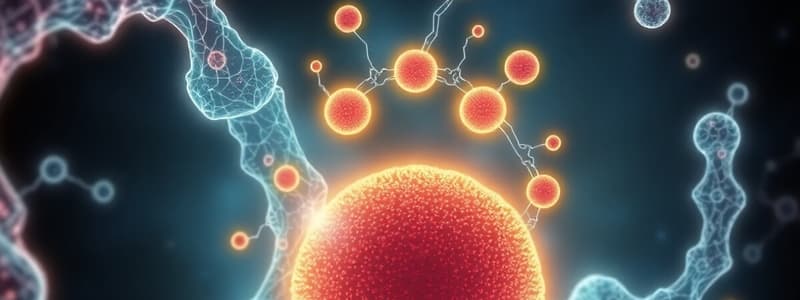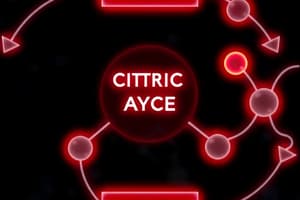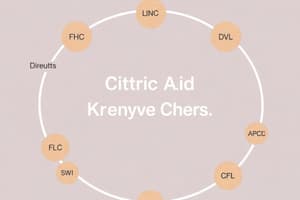Podcast
Questions and Answers
What is another name for the TCA cycle?
What is another name for the TCA cycle?
- Kreb's Cycle (correct)
- Electron Transport Chain
- Calvin Cycle
- Glycolysis
The TCA cycle occurs in the mitochondrial matrix.
The TCA cycle occurs in the mitochondrial matrix.
True (A)
The pyruvate dehydrogenase reaction converts pyruvate to ______.
The pyruvate dehydrogenase reaction converts pyruvate to ______.
acetyl-CoA
What is the net ATP production from one turn of the TCA cycle, considering the updated values for NADH and FADH2?
What is the net ATP production from one turn of the TCA cycle, considering the updated values for NADH and FADH2?
Which of the following is NOT a function of the TCA cycle?
Which of the following is NOT a function of the TCA cycle?
The conversion of pyruvate to acetyl-CoA by pyruvate dehydrogenase is a reversible reaction.
The conversion of pyruvate to acetyl-CoA by pyruvate dehydrogenase is a reversible reaction.
Match the following TCA cycle intermediates with their corresponding metabolic roles:
Match the following TCA cycle intermediates with their corresponding metabolic roles:
Which enzyme catalyzes the first committed step of the TCA cycle?
Which enzyme catalyzes the first committed step of the TCA cycle?
During the TCA cycle, two molecules of ______ are produced from each molecule of acetyl-CoA.
During the TCA cycle, two molecules of ______ are produced from each molecule of acetyl-CoA.
The isomerization reaction in the TCA cycle, converting citrate to isocitrate, is a key regulatory step.
The isomerization reaction in the TCA cycle, converting citrate to isocitrate, is a key regulatory step.
Which of the following enzymatic reactions in the TCA cycle directly produces ATP (or GTP)?
Which of the following enzymatic reactions in the TCA cycle directly produces ATP (or GTP)?
How many NADH molecules are generated from one turn of the TCA cycle?
How many NADH molecules are generated from one turn of the TCA cycle?
Red blood cells contain mitochondria and can therefore perform the TCA cycle.
Red blood cells contain mitochondria and can therefore perform the TCA cycle.
Which enzyme in the TCA cycle is also part of the electron transport chain?
Which enzyme in the TCA cycle is also part of the electron transport chain?
The two main products of the TCA cycle that are fed into the electron transport chain are NADH and ______.
The two main products of the TCA cycle that are fed into the electron transport chain are NADH and ______.
Briefly describe the role of oxaloacetate in the TCA cycle, and explain why it is important to regenerate it.
Briefly describe the role of oxaloacetate in the TCA cycle, and explain why it is important to regenerate it.
The reactions converting fumarate to malate and malate to oxaloacetate are both key regulatory steps in the TCA cycle.
The reactions converting fumarate to malate and malate to oxaloacetate are both key regulatory steps in the TCA cycle.
Which of the following molecules is an anaplerotic substrate that 'tops up' the TCA cycle?
Which of the following molecules is an anaplerotic substrate that 'tops up' the TCA cycle?
The irreversible enzyme ______ catalyzes the carboxylation of pyruvate to form oxaloacetate.
The irreversible enzyme ______ catalyzes the carboxylation of pyruvate to form oxaloacetate.
Why is the conversion of isocitrate to alpha-ketoglutarate considered a key reaction in the TCA cycle?
Why is the conversion of isocitrate to alpha-ketoglutarate considered a key reaction in the TCA cycle?
The TCA cycle is only involved in energy production and not in biosynthetic pathways.
The TCA cycle is only involved in energy production and not in biosynthetic pathways.
Which of the following is a precursor for porphyrin ring synthesis?
Which of the following is a precursor for porphyrin ring synthesis?
Alpha-ketoglutarate, an intermediate in the TCA cycle, can be converted to the amino acid ______ via transamination.
Alpha-ketoglutarate, an intermediate in the TCA cycle, can be converted to the amino acid ______ via transamination.
Why is the irreversible nature of certain TCA cycle steps important for the overall regulation of metabolism?
Why is the irreversible nature of certain TCA cycle steps important for the overall regulation of metabolism?
Increasing the levels of ATP and NADH typically stimulates the TCA cycle.
Increasing the levels of ATP and NADH typically stimulates the TCA cycle.
Besides ATP, what other high-energy intermediate is DIRECTLY produced in the reaction catalyzed by Succinyl-CoA synthetase during the TCA cycle?
Besides ATP, what other high-energy intermediate is DIRECTLY produced in the reaction catalyzed by Succinyl-CoA synthetase during the TCA cycle?
The enzyme that catalyzes the reaction directly before the entry of Acetyl-CoA into the TCA cycle is ______.
The enzyme that catalyzes the reaction directly before the entry of Acetyl-CoA into the TCA cycle is ______.
Explain why the TCA cycle is considered amphibolic.
Explain why the TCA cycle is considered amphibolic.
Suppose a researcher discovers a new inhibitor that specifically blocks the activity of aconitase. Which of the following outcomes would most likely be observed in cells treated with this inhibitor?
Suppose a researcher discovers a new inhibitor that specifically blocks the activity of aconitase. Which of the following outcomes would most likely be observed in cells treated with this inhibitor?
Imagine a scenario where a genetic mutation causes a complete loss of function in the malate dehydrogenase enzyme. How would this affect the cell's ability to perform gluconeogenesis, assuming all other enzymes are functioning normally and sufficient substrates are available?
Imagine a scenario where a genetic mutation causes a complete loss of function in the malate dehydrogenase enzyme. How would this affect the cell's ability to perform gluconeogenesis, assuming all other enzymes are functioning normally and sufficient substrates are available?
Flashcards
What is the TCA Cycle?
What is the TCA Cycle?
A series of chemical reactions used by all aerobic organisms to release stored energy through the oxidation of acetyl-CoA derived from carbohydrates, fats, and proteins.
TCA Cycle: Alternative Names?
TCA Cycle: Alternative Names?
Krebs Cycle, Citric Acid Cycle, Tricarboxylic Acid Cycle, Common Terminal Pathway
TCA Cycle: Definition
TCA Cycle: Definition
Oxidation of acetyl CoA to CO2 and water
TCA Cycle: Location
TCA Cycle: Location
Signup and view all the flashcards
TCA Cycle: Tissues
TCA Cycle: Tissues
Signup and view all the flashcards
TCA Cycle: Functions
TCA Cycle: Functions
Signup and view all the flashcards
Pyruvate to Acetyl-CoA Conversion
Pyruvate to Acetyl-CoA Conversion
Signup and view all the flashcards
Coenzyme A
Coenzyme A
Signup and view all the flashcards
Condensation Reaction
Condensation Reaction
Signup and view all the flashcards
Isomerisation
Isomerisation
Signup and view all the flashcards
First Loss of CO2
First Loss of CO2
Signup and view all the flashcards
Irreversibility of key stages
Irreversibility of key stages
Signup and view all the flashcards
NADH and H+ Production
NADH and H+ Production
Signup and view all the flashcards
FADH2 Production
FADH2 Production
Signup and view all the flashcards
GTP Production
GTP Production
Signup and view all the flashcards
Study Notes
- Lecture 14 is on the TCA Cycle of Biochemistry
TCA cycle
- Also known as the Krebs cycle, Citric acid cycle, or Tricarboxylic acid cycle
- The common terminal pathway for the catabolism of sugars, fats, and amino acids
- Oxidation of acetyl CoA to CO2 and water
- Located in the mitochondrial matrix in all tissues with mitochondria, except red blood cells or white muscle fibres
- Functions in energy trapping and biosynthesis of intermediates
Summary of TCA cycle events
- The events account for where carbon dioxide is lost and where carbon atoms are added into the cycle
- The pathway starts with a 2-carbon molecule which combines with a 4-carbon molecule to create a 6-carbon molecule
- Two carbons atoms are lost to get back to a 4 carbon molecule, to restart the cycle
- The individual names of the enzymes and substrates do not need to be memorized
- Uses a mnemonic device
Conversion of Pyruvate to Acetyl CoA
- Catalyzed by pyruvate dehydrogenase, occurs in the link reaction
- Result is 1 NADH and 1 CO2
Coenzyme A
- Forms thioester bonds with carboxylic acids
(1) Condensation reaction
- The first reaction to start the TCA cycle
- This is a key reaction
- Count the carbon atoms!
(2) Isomerisation
- A less significant reaction involving moving things around
(3) First loss of CO2
- This is a key reaction
- First loss of CO2 during the cycle
- Produces NADH
(4) Second loss of CO2
- This is a key reaction
- Second loss of CO2 during the cycle
- Produces NADH
Why continue the cycle?
- Acetyl CoA has only 2 carbon atoms and 2 carbons have already been lost through the previous two decarboxylation reactions
- The the cycle regenerates oxaloacetate and also generate more high energy intermediates like NADH and FADH2
(5) Trapping thioester bond energy
- Occurs as GTP
- This is a key reaction
- It produces ATP (as GTP)
(6) Conversion of succinate to fumarate
- This is a key reaction
- Produces FADH2
(7) Conversion of fumarate to malate
- A less significant reaction involving just adding water
(8) Conversion of malate to oxaloacetate
- This is a key reaction
- Produces NADH
- Re-forms OAA, now ready to start the cycle again!
Generation of ATP
- The re-oxidation of NADH to NAD+ and FADH2 to FAD via the Electron Transport Chain results in synthesis of ATP from ADP and Pi (Oxidative Phosphorylation)
Energy yields of TCA cycle
- Three enzyme reactions produce NADH and H+
- One enzyme reaction produces FADH2
- One enzyme reaction produces GTP
- ATP yields = 3 x 3 ATP5 + 1 x 2 ATP + 1GTP or 10 ATP old numbers ATD new numbers
Energy yields from 1 molecule of glucose
- Glycolysis: 2 ATP, 2NADH (2x2.5 = 5 ATP) 7 ATP
- Link reaction: 1 NADH (do it 2x for each pyruvate) 5ATP
- TCA Cycle: 10 ATP per turn (2 turns) 20 ATP
Irreversibility of key stages
- 3 enzyme steps are highly exergonic & irreversible: citrate synthase, isocitrate dehydrogenase, and a-ketoglutarate dehydrogenase
Biosynthetic role of TCA cycle
- Role in biosynthetic processes, in the production of for instance, other amino acids, purines, pyrimidines, aspartate, Glutamate & haem
Anaplerotic ‘topping up' of TCA cycle
- Reintroduces key molecules, the pyrivate carboxylase reaction regenerates glucose from pyruvate
Studying That Suits You
Use AI to generate personalized quizzes and flashcards to suit your learning preferences.




